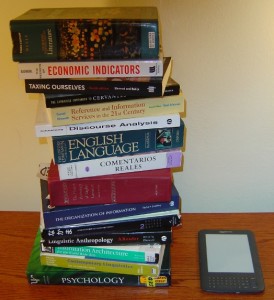 Amazon’s recent unveiling of a Kindle Textbook Rental Service
Amazon’s recent unveiling of a Kindle Textbook Rental Service, which allows students to rent electronic versions of “tens of thousands of textbooks,” is the latest news in the radically changing textbook publishing market. Amazon boasts savings up to 80% of the print cover price, offers very flexible rental periods, and enables students to access their texts on a Kindle, laptop, tablet or mobile device and even make notes and highlights that will remain after the rental expires.
Behind these impressive features, however, lie some concerns. For one, a cheap 30-day rental of the textbook is a strong incentive for some college students to blow off a course until the very last month. Also, the Kindle’s grayscale display and less-than-optimal navigation currently leave a lot to be desired, and the majority of students do not yet have tablets. This model also assumes that all professors will allow these devices in their class sessions.
In addition, when students’ textbooks are housed on tablets and laptops that also have email and Facebook and countless other distractions, will students stay on task? There are also issues with the effect of the quality of learning with etextbooks. CNET reported on a University of Washington study which found that “students had a harder time switching among looking over illustrations, skimming references and reading the full text using e-readers compared with reading printed textbooks. E-readers also disrupted cognitive mapping, the process students use to find and recall information by remembering where it is in the book and where it’s positioned on the page.”
Despite these concerns, however, the benefits of electronic textbooks in general are significant. Students don’t have to lug around a bunch of heavy print books, and they have instant access to any title wherever they go. The searchability of ebooks cuts down on time spent flipping through hundreds of pages. The lack of material costs translates to much cheaper prices. And as these programs evolve, publishers can incorporate more multimedia and interactive content, instead of merely representing print texts in digital form.
In addition to Amazon, there are numerous other players in the picture. Barnes and Noble already has an eTextbook service with an accompanying NookStudy application, “a powerful study and organization tool that enables users to tag content, highlight sections and access coursework in one convenient place.” Barnes and Noble also provides etextbook rentals for some titles, but they are limited to a 180-day period and two devices and did not appear to offer significant enough savings to warrant a rental rather than a purchase.
Publishers are also active in moving toward the digital future, as McGraw-Hill recently launched a new ebook platform with over 1,000 technical textbooks bundled as a subscription service for institutions. In addition, they are working on a new program known as CINCH Learning, a cloud-based, self-described “paradigm-changing” curriculum for the K-12 market.
These types of services are expected to soar in popularity in the coming years. A recent five-year projection by an educational firm says that etextbooks will grow to 26% of the market share by 2015 and 44% by 2017.
Instead of merely making students’ backpacks lighter, etextbooks represent a major market shakeup. In recent decades, publishers have had no choice but to continually raise prices because of the used-book industry and the popularity of textbook-sharing programs among students. The switch to electronic form offers an opportunity for a “reset” and the development of new business models that make more sense in today’s climate.
Etextbooks that can be purchased once and then dynamically updated have the power to solve many traditional problems, especially in scientific and technical areas of study where things change very quickly. Setting up a model where a student or institution can purchase an etextbook with guaranteed updates for a set length of time ensures that their information will stay current without requiring them to buy the entire book again, as is the only option with print books.
Amazon did a pretty good job of convincing us that we need an ereader for pleasure reading; will they be able to do the same with textbooks? Where do publishers and universities fit into the equation? What rights should purchasers have over the content? How long until all of our classes are taught through interactive, digital means? The next few years will certainly be interesting as all of this continues to play out, especially now that Amazon’s Textbooks for Kindle is directly competing with Apple’s revamped iBooks Author platform.




Leave a Reply